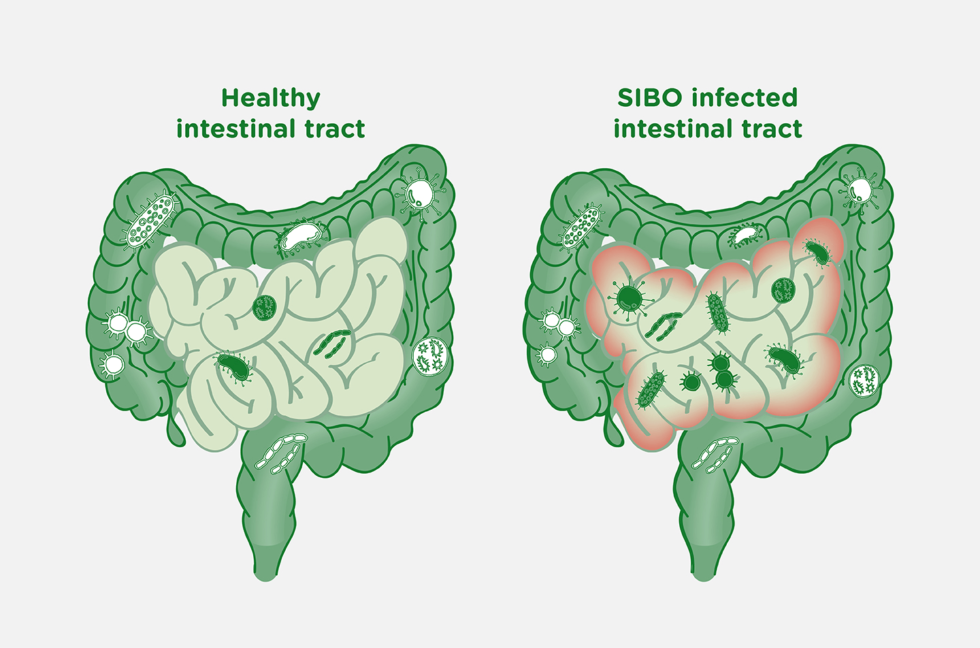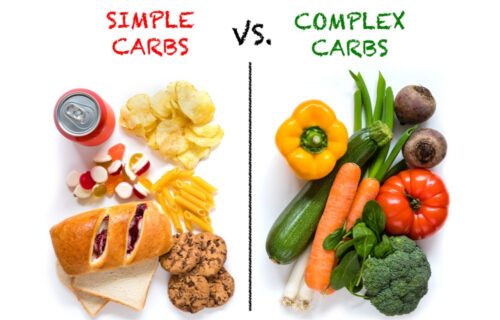
S.I.B.O.
What is it?
Kind of the case of being in the wrong place at the wrong time.
S.I.B.O. = Small Intestine Bacterial Overgrowth and is an accumulation of bacteria in the small intestine. It is defined as an increase in the number of bacteria, and/or changes in the types of bacteria present in the small bowel. In most patients, SIBO is not caused by a single type of bacteria, but is an overgrowth of the various types of bacteria that should normally be found in the colon. Less commonly, SIBO results from an increase in the otherwise normal bacteria of the small bowel.
So why is it a problem?
SIBO has been shown to negatively affect both the structure and function of the small bowel. It may significantly interfere with digestion of food and absorption of nutrients, primarily by damaging the cells lining the small bowel (the mucosa). Additionally, this damage to the small bowel mucosa can lead to leaky gut (when the intestinal barrier becomes permeable, allowing large protein molecules to escape into the bloodstream), which is known to have a number of potential complications including immune reactions that cause food allergies or sensitivities, generalized inflammation, and autoimmune diseases.
These pathogenic bacteria, whether too many or the wrong types, can lead to nutritional deficiencies on top of those due to poor digestion or absorption. In particular, the bacteria will take up certain B vitamins, such as vitamin B12, before our own cells have a chance to absorb these important nutrients. They may also consume some of the amino acids, or protein, that you’ve eaten, which can lead to both protein deficiency and an increase in ammonia production by certain bacteria. (We normally produce some ammonia daily from normal metabolism, but ammonia requires detoxification, so this may add to an already burdened detoxification system.) The bacteria may also decrease fat absorption through their effect on bile acids, leading to deficiencies in fat soluble vitamins like A and D
Carbohydrates feed SIBO → SIBO produces hydrogen → hydrogen feeds archaea → archaea produces methane
Let’s go back a step –
What is the role of the SI?
The normal small bowel, which connects the stomach to the large bowel, is approximately 20 feet long. The small bowel plays an important role in digesting food and absorbing nutrients. It is also an important part of the immune system, containing a large network of lymphoid cells (cells of the immune system that help fight infections and regulate the immune system).
The normal (beneficial) bacteria that are an essential part of the healthy small bowel also perform important functions. These beneficial microorganisms help protect against bad (i.e. pathogenic) bacteria and yeast that are ingested. They help the body absorb nutrients, and also produce several nutrients (such as short chain fatty acids) and vitamins like folate and vitamin K. These bacteria help maintain the normal muscular activity of the small bowel, which creates waves that move the intestinal contents, like food, through the gut, ie motility.
Bacteria are normally present throughout the entire gastrointestinal tract, but in varied amounts. Relatively few bacteria normally live in the small bowel (less than 10,000 bacteria per ml of fluid) when compared with the large bowel, or colon (at least 1,000,000,000 bacteria per ml of fluid). And, the types of bacteria normally present in the small bowel are different from those in the colon.
So what causes SIBO?
SIBO is associated with various conditions, such as:
- A bout of gastro
- Celiac disease
- Crohns disease
- Low stomach acid
- Gastroparesis
- Nerve damage (eg previous abdominal surgery)
- Cirrhosis
- Portal hypertension
- Irritable bowel syndrome
- Some gastric bypass procedures
- Slow movement of the digestive system
- Weakened immune system
- pH changes in small bowel
- Diabetes mellitus (type I and type II)
- Multiple courses of antibiotics
- Organ system dysfunction, such as liver cirrhosis, chronic pancreatitis, or renal failure
How do you know if you have it?
What are the Symptoms?
The most common symptoms include:
- Abdominal pain/discomfort – especially after eating
- Bloating and abdominal distention
- Cramping in abdomen
- Diarrhoea
- Indigestion
- Feeling of fullness
- Constipation (generally associated with methanogens)
- Gas and belching
- In more severe cases, there may be weight loss and symptoms related to vitamin deficiencies.
Is there a way to be sure?
Testing
Note: 80% of people with IBS have SIBO
Breath test
A breath test is a common test for diagnosing SIBO. Excess bacteria in the small intestine can lead to the release of the gases hydrogen and methane, which can be identified through a breath test. This test is non-invasive and can be performed at home or in a clinic.
You’ll need to fast overnight before having a breath test. During the test, you’ll breathe into a tube. You’ll then drink a special sweet drink provided in the kit. You’ll breathe into a series of additional tubes at regular intervals for 2 to 3 hours after consuming the drink.
Further testing
If the breath test isn’t conclusive or SIBO treatments aren’t working, you may need to have a sample from your small bowel to see what bacteria is growing there.
It is always suggested to re-test after treatment too.
How do you treat it?
It can be difficult to treat SIBO as it needs a multi-layered approach and time, as well as discipline.
Many studies have been done to compare outcomes when people are treated with antibiotics or botanicals – there is mixed results as there is more to it – including dietary changes.
Plus, it is suggested that treatment of the overgrowth alone is not enough for most people. An additional part of successful treatment must include addressing the underlying cause, or predisposing factor.
Though there are many identified associations between SIBO and other diseases as described above, abnormalities in gut motility (bowel transit time) are recognized as one of the most common associations. This is where the multi factorial approach is required and the introduction of prokinetic agents (to increase the muscular contractions of the small bowel) are required.
If you look at my article on Gut Repair using the 5R program you will see treatment for SIBO is based on these steps.
- Reduce
- Remove
- Replace
- Repopulate
- Repair
REDUCE
Diet and SIBO
There’s no evidence to prove that a certain diet causes SIBO, but many people with SIBO have found relief after following a special diet. The aim being to deprive the bacteria of its food source, whilst still feeding the patient.
As bacteria feed off carbohydrates, most diet recommendations include reducing these and thus gas. Also included is limiting fermentable foods. The different diets recommended include SCD, Gaps, low FODMAP, or a combination including the Bi-Phasic Diet.
I will go into more detail about these diets in another post.
REMOVE
With diet keeping symptoms under control, the next step is to remove the overgrowth. There are three main options here; natural antimicrobials, antibiotics and the elemental diet. Because of SIBO’s notorious stubbornness, for many clients their treatment will involve a combination of two or even three of these approaches over successive protocols. Each has its strengths and weaknesses and are more or less suited to different clients – there is no one ‘magic protocol’ for all SIBO cases. With that in mind, I’ll discuss each one in the order they are most commonly used.
Antibiotics
Antibiotics (mainly Rifamximin and Neomycin) are often used to treat SIBO. However, studies show that despite treatment with antibiotics, recurrence develops in almost half of all patients within one year. This may be due to the underlying issue cause not being addressed.
This approach aims to kill off bacterial overgrowth quickly. It does appear effective. Occasionally Metronidazole, which is a more systemic antibiotic is used.
As research into SIBO continues, we are increasingly understanding the complexity of this disease, and how treatment must be tailored to each individual to maximize success.
Herbals
Like pharmaceutical antibiotics, this approach aims to attack the bacterial overgrowth fairly quickly. It must be followed with preventative measures. Multiple studies site that it is as effective as pharmaceutical option. However, the main point to remember is it is VERY individual.
The difficulty here is finding the right combination and dose for each individual at the right stage.
Generally, they include anti-microbials and anti-fungals. But will also include high dose allicin from garlic and Berberine from specific medicinal herbs.
Other
Neem – anti bacterial, antifungal and antiviral. Also an anti-
inflammatory amongst other things
Biofilm eradication – after antimicrobials
REPLACE
It is also important to support digestion and absorption of the nutrients you eat. We do this because an overgrowth in the small intestine will block the intestinal lining where absorption of the nutrients in the foods we eat happens.
This means taking supplements like digestive enzymes that help you break down and absorb the foods you eat; stomach acid support from betaine HCL to help with killing off any bad bacteria that is contaminating the foods you eat; and nutritional support in the form of anti-inflammatory fish oil capsules, hydrolysed protein for easily absorbed amino acids and multi-minerals supplements if needed.
Other
Digestive aids – to help heal the brush borders enzymes if needed eg
digestive bitters
Detoxing is a MUST
The next thing we need to focus on in this phase is supporting the body with detoxification. During die-off of the bacterial overgrowth, there is a build-up of toxins in the body that needs to be removed.
Prokinetics are important here too. To keep the migrating motor complex working optimally – this is like the cleansing wave that occurs about every 90 minutes (another reason to allow time between meals).
Things like charcoal and bentonite clay can help when they are actively killing off the overgrowth, to help with removal of the toxins and debris from the gastrointestinal tract.
REPOPULATE
Probioitics – but which one?
The final step is to restore the good bacteria in your gut. This will help support a strong immune system, optimal digestion, and nutrient absorption. However, when it comes to SIBO you want to be particularly careful. Certain probiotics can add fuel to the fire.
One clue that you may have SIBO is that probiotics containing lactobacillus or bifidobacterium exacerbate your symptoms. You may experience more gas, bloating, constipation, diarrhea or other digestive symptoms.
This is an area of much debate still. One main point is to avoid prebioitcs as these feed the bacteria.
REPAIR
Absorption – Digestive support
Immune Support – by increasing nutrient intake and absorption through healing the intestinal lining
Brush borders – Repair the microvilli that constitute the brush border so the enzymes can work to break down disaccharides and starches
MMC – As mentioned above the migrating motor complex is a cyclic, recurring motility pattern that occurs in the stomach and small bowel during fasting; it is interrupted by feeding. This needs to be supported for healing and prevention of relapse.
Secretory IgA – Is the principal weapon protecting us from pathogens and toxins that might otherwise penetrate mucosal surfaces.
Depleted nutrients – after possible years of depleted nutrients, especially; folate, B12, magnesium and iron.
Maintenance – SIBO relapse prevention
With SIBO relapse rates commonly reported up to a year after eradication, the maintenance phase should last between 6 – 12 months after completing natural herbal antibiotics for SIBO and a retest without any elevations in hydrogen or methane gas.
If you find that you’re symptoms continue or return, you might need to retest or consider testing for and address parasites, bacteria or yeast in the large intestine, SIFO, or ongoing inflammation from food sensitivities. Remember, symptoms are a sign that there is an underlying imbalance in systems of the body that need to be healed (not ignored).
Have more questions? Feel free to contact me .




Pingback: Leaky Gut | Sally Pattison